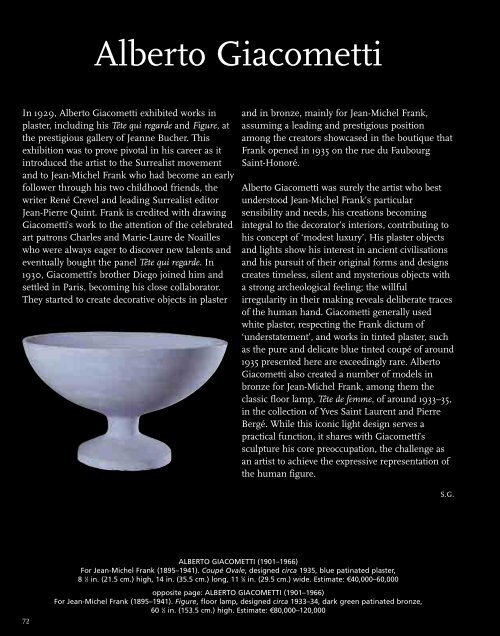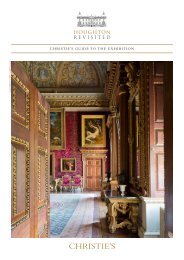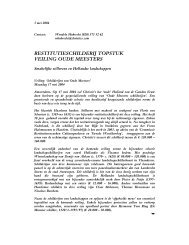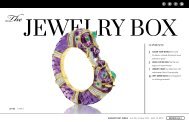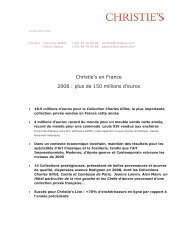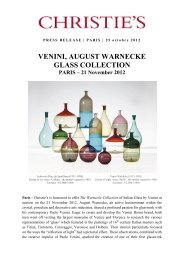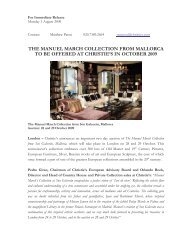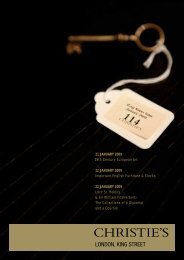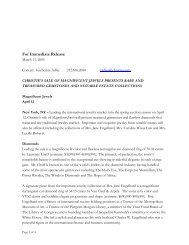Yves Saint Laurent Pierre Bergé - Christie's
Yves Saint Laurent Pierre Bergé - Christie's
Yves Saint Laurent Pierre Bergé - Christie's
Create successful ePaper yourself
Turn your PDF publications into a flip-book with our unique Google optimized e-Paper software.
In 1929, Alberto Giacometti exhibited works in<br />
plaster, including his Tête qui regarde and Figure, at<br />
the prestigious gallery of Jeanne Bucher. This<br />
exhibition was to prove pivotal in his career as it<br />
introduced the artist to the Surrealist movement<br />
and to Jean-Michel Frank who had become an early<br />
follower through his two childhood friends, the<br />
writer René Crevel and leading Surrealist editor<br />
Jean-<strong>Pierre</strong> Quint. Frank is credited with drawing<br />
Giacometti’s work to the attention of the celebrated<br />
art patrons Charles and Marie-Laure de Noailles<br />
who were always eager to discover new talents and<br />
eventually bought the panel Tête qui regarde. In<br />
1930, Giacometti’s brother Diego joined him and<br />
settled in Paris, becoming his close collaborator.<br />
They started to create decorative objects in plaster<br />
72<br />
Alberto Giacometti<br />
and in bronze, mainly for Jean-Michel Frank,<br />
assuming a leading and prestigious position<br />
among the creators showcased in the boutique that<br />
Frank opened in 1935 on the rue du Faubourg<br />
<strong>Saint</strong>-Honoré.<br />
Alberto Giacometti was surely the artist who best<br />
understood Jean-Michel Frank’s particular<br />
sensibility and needs, his creations becoming<br />
integral to the decorator’s interiors, contributing to<br />
his concept of ‘modest luxury’. His plaster objects<br />
and lights show his interest in ancient civilisations<br />
and his pursuit of their original forms and designs<br />
creates timeless, silent and mysterious objects with<br />
a strong archeological feeling; the willful<br />
irregularity in their making reveals deliberate traces<br />
of the human hand. Giacometti generally used<br />
white plaster, respecting the Frank dictum of<br />
‘understatement’, and works in tinted plaster, such<br />
as the pure and delicate blue tinted coupé of around<br />
1935 presented here are exceedingly rare. Alberto<br />
Giacometti also created a number of models in<br />
bronze for Jean-Michel Frank, among them the<br />
classic floor lamp, Tête de femme, of around 1933–35,<br />
in the collection of <strong>Yves</strong> <strong>Saint</strong> <strong>Laurent</strong> and <strong>Pierre</strong><br />
<strong>Bergé</strong>. While this iconic light design serves a<br />
practical function, it shares with Giacometti’s<br />
sculpture his core preoccupation, the challenge as<br />
an artist to achieve the expressive representation of<br />
the human figure.<br />
ALBERTO GIACOMETTI (1901–1966)<br />
For Jean-Michel Frank (1895–1941). Coupé Ovale, designed circa 1935, blue patinated plaster,<br />
8 1 ⁄2 in. (21.5 cm.) high, 14 in. (35.5 cm.) long, 11 5 ⁄8 in. (29.5 cm.) wide. Estimate: 340,000–60,000<br />
opposite page: ALBERTO GIACOMETTI (1901–1966)<br />
For Jean-Michel Frank (1895–1941). Figure, floor lamp, designed circa 1933–34, dark green patinated bronze,<br />
60 1 ⁄2 in. (153.5 cm.) high. Estimate: 380,000–120,000<br />
S.G.


